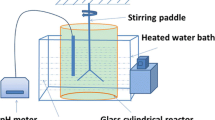Abstract
In this study, chemical oxidation was applied to treat three contaminated sediments. All the sediments were contaminated with mineral oil, polycyclic aromatic hydrocarbons and heavy metals and had an organic matter content ranging from 2.4 to 7.6 %. The natural oxidant demand of the sediments was determined during treatment with two different types of oxidants (potassium permanganate and sodium persulfate), and the effect of these oxidants on the heavy metal release and on the microbial community was investigated. The natural oxidant demands of the sediments under persulfate treatment were lower (30–100 g kg−1) than the ones treated with permanganate (50–450 g kg−1). Cr was released during the application of permanganate whereas Zn and Pb were released under persulfate treatment. qPCR results showed that permanganate and persulfate, both at a concentration of 150 g kg−1, caused a decrease (2 log units) in the number of 16S rRNA gene of total bacteria in the sediment having the lowest organic matter content. However, the total ATP, considered as a biomarker for microbial activity, was below detection limit in all sediments in the presence of at least 150 g kg−1 oxidant. Only permanganate induced a shift in the structure of the microbial community.


Similar content being viewed by others
References
American Public Health Association (APHA) (2005). Standard method for the examination of water and wastewater, 21st edn. Washington D.C.
Baumler, D. J., Hung, K., Jeong, K. C., & Kaspar, C. W. (2008). Molybdate treatment and sulfate starvation decrease ATP and DNA levels in Ferroplasma acidarmanus. Archaea, 2, 205–209.
Boon, N., De Windt, W., Verstraete, W., & Top, E. M. (2002). Evaluation of nested PCR-DGGE (denaturing gradient gel electrophoresis) with group-specific 16S rRNA primers for the analysis of bacterial communities from different wastewater treatment plants. FEMS Microbiology Ecology, 39, 101–112.
Brown, R. A., Lewis, R., Leahy, M. C., & Luhrs, R. (2009). Is there life after ISCO? The Effect of Oxidants on In Situ Bioremediation, In Situ and On-Site Bioremediation, Tenth International In Situ and On-Site Bioremediation Symposium, Baltimore, MD, May 5–8.
Bui, C. T., & Cotton, R. G. H. (2002). Comparative study of permanganate oxidation reactions of nucleotide bases by spectroscopy. Bioorganic Chemistry, 30, 133–137.
Cabiscol, E., Tamarit, J., & Ros, J. (2000). Oxidative stress in bacteria and protein damage by reactive oxygen species. International Microbiology, 3, 3–8.
Calmano, W., Hong, J., & Forstner, U. (1993). Binding and mobilization of heavy metals in contaminated sediments affected by pH and redox potential. Water Science and Technology, 28(7–8), 223–235.
Chaîneau, C. H., Yepremian, C., Vidalie, J. F., Ducreux, J., & Ballerini, D. (2003). Bioremediation of a crude oil-polluted soil: biodegradation, leaching and toxicity assessments. Water, Air, Soil Pollution, 144, 419–440.
Chapelle, F. H., Bradley, P. M., & Casey, C. C. (2005). Behavior of a chlorinated ethene plume following source-area treatment with Fenton’s reagent. Ground Water Monitoring Remediation, 25(2), 131–141.
Chardin, B., Dolla, A., Chaspoul, F., Fardeau, M. L., Gallice, P., & Bruschi, M. (2002). Bioremediation of chromate: thermodynamic analysis of the effects of Cr(VI) on sulfate-reducing bacteria. Applied Microbiology and Biotechnology, 60, 352–360.
Crimi, L. M., & Siegrist, R. L. (2003). Geochemical effects on metals following permanganate oxidation of DNAPLs. Ground Water, 41, 458–469.
Crimi, M. L., & Siegrist, R. L. (2005). Factors affecting effectiveness and efficiency of DNAPL destruction using potassium permanganate and catalyzed hydrogen peroxide. Journal of Environmental Engineering, 131(12), 1724–1732.
Dahmani, M. A., Huang, K., & Hoag, G. E. (2006). Sodium persulfate oxidation for the remediation of chlorinated solvents (USEPA Superfund Innovative Technology Evaluation Program). Water Air Soil Pollution Focus., 6, 127–141.
Edmond, E. L., & Dhanpat, R. (1987). Kinetics of chromium(III) oxidation to chromium(VI) by reaction with manganese dioxide. Environmental Science and Technology, 21(12), 1187–1193.
EN 13137 (2001). Characterization of waste—determination of total organic carbon (TOC) in waste, sludges and sediments.
EN 14346 (2006). Characterization of waste—calculation of dry matter by determination of dry residue or water content.
European Committee for Standardization (CEN) (2002). Characterization of waste—leaching—compliance test for leaching of granular waste materials and sludges, EN 12457-2.
Griebler, C., Mindl, B., Slezak, D., & Geiger-Kaiser, M. (2002). Distribution patterns of attached and suspended bacteria in pristine and contaminated shallow aquifers studied with an in situ sediment exposure microcosm. Aquatic Microbial Ecology, 28, 117–129.
Guo, T., DeLaune, R. D., & Patrick, W. H., Jr. (1997). The influence of sediment redox chemistry on chemically active forms of arsenic, cadmium, chromium, and zinc in estuarine sediment. Environment International, 23(3), 305–316.
Hartog, N., Griffioen, J., & Van der Weijden, C. H. (2002). Distribution and reactivity of O2-reducing components in sediments from a layered aquifer. Environmental Science and Technology, 36, 2338–2344.
Hartog, N., Griffioen, J., & Van Bergena, P. F. (2005). Depositional and paleohydrogeological controls on the distribution of organic matter and other reactive reductants in aquifer sediments. Chemical Geology, 216, 113–131.
Hendrickx, B., Dejonghe, W., Boënne, W., Brennerova, M., Cernik, M., Lederer, T., et al. (2005). Dynamics of an oligotrophic bacterial aquifer community during contact with a groundwater plume contaminated with benzene, toluene, ethylbenzene, and xylenes: an in situ mesocosm study. Applied and Environmental Microbiology, 71, 3815–3825.
Ho, K. T., Burgess, R. M., Pelletier, M. C., Serbst, J. R., Ryba, S. A., Cantwell, M. G., et al. (2002). An overview of toxicant identification in sediments and dredged materials. Marine Pollution Bulletin, 44, 286–293.
Hønning, J. (May 2007). Use of chemical oxidation with permanganate in PCE-contaminated clayey till with sand lenses. Ph.D. Thesis, Institute of Environment & Resources, Technical University of Denmark.
Hous, W. A., & Denison, F. H. (2002). Total phosphorus content of river sediments in relationship to calcium, iron and organic matter concentrations. Science of the Total Environment, 282–283, 341–351.
Imlay, J. A., & Linn, S. (1988). DNA damage and oxygen radical toxicity. Science, 240(4857), 1302–1309.
Jorgensen, K. S., Puustinen, J., & Suortti, A. M. (2000). Bioremediation of petroleum hydrocarbon-contaminated soil by composting in biopiles. Environmental Pollution, 107, 245–254.
Jung, H., Ahn, Y., Choi, H., & Kim, I. S. (2005). Effects of in-situ ozonation on indigenous microorganisms in diesel contaminated soil: survival and regrowth. Chemosphere, 61, 923–932.
Kao, C. M., Huang, K. D., Wang, J. Y., Chen, T. Y., & Chien, H. Y. (2008). Application of potassium permanganate as an oxidant for in situ oxidation of trichloroethylene-contaminated groundwater: a laboratory and kinetics study. Journal of Hazardous Materials, 153, 919–927.
Karl, D. M. (1993). Total microbial biomass estimation derived from the measurement of particulate adenosine-5′-triphospate. Handbook of method in aquatic microbial ecology (pp. 359–367). Boca Raton: Lewis.
Kozubek, P., Cagigal, E., & Sutton, N. (2012). Heavy Metals Leachability and Associated Risks after ISCO Treatment, Remediation Technologies and their Integration in Water Management Symposium, September 25–26, Barcelona.
Leloup, J., Fossing, H., Kohls, K., Holmkvist, L., Borowski, C., & Jørgensen, B. B. (2009). Sulfate-reducing bacteria in marine sediment (Aarhus Bay, Denmark): abundance and diversity related to geochemical zonation. Environmental Microbiology, 11, 1278–1291.
Li, X. (2002). In situ chemical oxidation schemes for the remediation of ground water and soils contaminated by chlorinated solvents. Ph.D. Thesis, Graduate School of The Ohio State University The Ohio State University.
Liang, C., Bruell, C. J., Marley, M. C., & Sperry, K. L. (2004). Persulfate oxidation for in situ remediation of TCE. I. Activated by ferrous ion with and without a persulfate–thiosulfate redox couple. Chemosphere, 55, 1213–1223.
Liang, C., Wang, Z., & Bruell, C. J. S. (2007). Influence of pH on persulfate oxidation of TCE at ambient temperatures. Chemosphere, 66, 106–113.
Lin, W. C., Coppi, M. V., & Lovley, D. R. (2004). Geobacter sulfurreducens can grow with oxygen as a terminal electron acceptor. Applied and Environmental Microbiology, 70(4), 2525–2528.
Miao, S., DeLaune, R. D., & Jugsujinda, A. (2006). Influence of sediment redox conditions on release/solubility of metals and nutrients in a Louisiana Mississippi River deltaic plain freshwater lake. Science of the Total Environment, 371, 334–343.
Mumford, K. G., Lamarche, G. S., & Thomson, N. L. (2004). Natural oxidant demand of aquifer materials using the push–pull technique. Journal of Environmental Engineering, 130, 1139–1146.
Mumford, K. G., Thomson, N. T., & Allen-King, R. M. (2005). Bench-scale investigation of permanganate natural oxidant demand kinetics. Environmental Science and Technology, 39, 2835–2840.
Muyzer, G., De Waal, E. C., & Uitterlinden, A. G. (1993). Profiling of complex microbial populations by denaturing gradient gel electrophoresis analysis of polymerase chain reaction-amplified genes encoding for 16S rRNA. Applied and Environmental Microbiology, 59, 695–700.
Ramsey, M. A., Swannell, R. P. J., Shipton, N. W. A., Duke, N. C., & Hill, R. T. (2000). Effect of bioremediation on the microbial community in oiled mangrove sediments. Marine Pollution Bulletin, 41, 413–419.
Richardson, S. D., Lebron, B. L., Miller, C. T., & Aitken, M. D. (2011). Recovery of phenanthrene-degrading bacteria after simulated in situ persulfate oxidation in contaminated soil. Environmental Science and Technology, 45, 719–725.
Rock, M. L., James, B. R., & Helz, G. R. (2001). Hydrogen peroxide effects on chromium oxidation state and solubility in four diverse, chromium-enriched soils. Environmental Science and Technology, 35, 4054–4059.
Rosta, U., Joergensen, R. G., & Chandera, K. (2001). Effects of Zn enriched sewage sludge on microbial activities and biomass in soil. Soil Biology and Biochemistry, 33, 633–638.
Sahl, J., & Munakata-Marr, J. (2006). The effects of in situ chemical oxidation on microbiological processes: a review. Remediation, 16, 57–70.
Sra, K. S., Whitney, J. J., Thomson, N. R., & Barker, J. F. (2007). Persulfate decomposition kinetics in the presence of aquifer materials. Proceedings of the Annual International Conference on Soils, Sediments, Water and Energy, 12(29).
Stephens, S. R., Alloway, B. J., Parker, A., Carter, J. E., & Hodson, M. E. (2001). Changes in the leachability of metals from dredged canal sediments during drying and oxidation. Environmental Pollution, 114(3), 407–413.
Studer, J., Davis, G., Baldwin, B., & Cronk, G. (2009). Impact of in situ chemical oxidation on native biological populations—review of case studies, in situ and on-site bioremediation. Tenth International In Situ and On-Site Bioremediation Symposium, Baltimore, MD; May 5–8.
Tack, M. G., Singh, S. P., & Verloo, M. G. (1999). Leaching behaviour of Cd, Cu, Pb and Zn in surface soils derived from dredged sediments. Environmental Pollution, 106, 107–114.
Trevors, J. T. (1996). DNA in soil: adsorption, genetic transformation, molecular evolution and genetic microchip. Antonie Van Leeuwenhoek, 70, 1–10.
Tsitonaki, A., Smets, B. F., & Bjerg, P. L. (2008). Effects of heat-activated persulfate oxidation on soil microorganisms. Water Research, 42, 1013–1022.
Tsitonaki, A., Petri, B., Crimi, M., Mosbæk, H., Siegrist, R. L., & Bjerg, P. L. (2010). In situ chemical oxidation of contaminated soil and groundwater using persulfate: a review. Critical Reviews in Environmental Science and Technology, 40, 55–91.
U.S. EPA (May 2004). United States Environmental Protection Agency, Chemical Oxidation, Report.
Vanbroekhoven, K., Van Roy, S., Gielen, C., Maesen, M., Ryngaert, A., Diels, L., et al. (2007). Microbial processes as key drivers for metal (im)mobilization along a redox gradient in the saturated zone. Environmental Pollution, 148, 759–769.
Waldemer, R. H., Tratnyek, P. G., Johnson, R. L., & Nurmi, J. T. (2007). Oxidation of chlorinated ethenes by heat-activated persulfate: kinetics and products. Environmental Science and Technology, 41, 1010–1015.
Acknowledgments
The research has received funding from the European Community’s Seventh Framework Program FP7/2007-2013 under grant agreement no 212683 (GOODWATER) and from the Innovation in Environmental and Energy Technology platform in the frame of the project ‘In situ conditioning of dredged and mineral sludge’. We would like to thank the Port of Antwerp and Ghent Dredging for providing the sediment samples. The authors would like to thank Agnieszka Herzyk for her contributions and advices during ATP measurements, Leen Smets for performing heavy metal analysis and Yamini Satyawali and one anonymous reviewer for their helpful comments on the manuscript.
Author information
Authors and Affiliations
Corresponding author
Rights and permissions
About this article
Cite this article
Doğan, E., Accoe, F., Boon, N. et al. Impact of Chemical Oxidants on the Heavy Metals and the Microbial Population in Sediments. Water Air Soil Pollut 224, 1386 (2013). https://doi.org/10.1007/s11270-012-1386-z
Received:
Accepted:
Published:
DOI: https://doi.org/10.1007/s11270-012-1386-z




